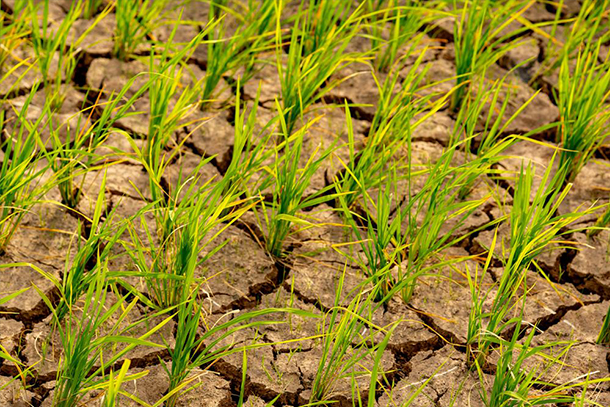
Rice typically requires significant water to grow, but farmers in more drought-prone areas are switching to a different variety that can better withstand droughts in an effort to adapt to the impacts of climate change. Credit: Ritthichai/Getty Images.
Adapting to climate change: Individuals take action while governments plan
Individuals are the predominant actors implementing climate change adaptations, study finds
October 24, 2023
By Ashley WennersHerron
Editor’s note: This article originally appeared on Penn State News.
UNIVERSITY PARK, Pa. — While governments may take the lead in planning and financing climate change adaptation measures, such as incentivizing green infrastructure, individuals currently are most often the ones implementing actions to adapt to climate change, according to new research. The analysis, conducted by an international consortium of researchers from 20 institutions, including Penn State, in 12 countries, published in Nature Climate Change.
“The evidence suggests that individuals and households are the primary adaptation actors — the ones actually implementing ways to adapt to the changes wrought by climate change,” said study co-author Christine Kirchhoff, associate professor of civil and environmental engineering and of law, policy and engineering at Penn State. “Geographically, in higher income countries, the government may begin to take the lead in planning or financing, but individuals are the ones taking action on the ground.”
Adaptations taken by individuals include planting crops more resilient to extreme weather, moving away from areas more directly impacted by storms and flooding, and implementing behavioral changes — such as changing their outdoor working hours to cooler parts of the day, among other actions.
“Individuals are primarily focused on changing what they can control: their own behaviors,” said Elphin Tom Joe, paper co-author and doctoral student at Penn State who works with Kirchhoff. “That’s needed, but so is action from institutional actors who can coordinate more broadly impactful adaptation.”
The study, led by Jan Petzold of Ludwig-Maximillians-University of Munich, is a deeper dive into findings from the Global Adaption Mapping Initiative (GAMI), which was developed to systematically assess the peer-reviewed scientific literature as the evidence base on adaptation progress.
“From the GAMI project, we found that the larger effort global adaptation is still nascent and certainly not transformative in changing hearts and minds in broadscale adaptation initiatives,” said Kirchhoff, who is also associate director of the Law, Policy and Engineering initiative at Penn State.
The researchers examined 1,472 scientific studies on human adaption to climate change from the GAMI database and coded them by types of actors leading the adaptation measures: individuals or households; civil society, from local to international; government, from local to national; international or multinational governance institutions; and private sectors.
On average, across the globe, individuals and households were doing the most to adapt, followed by governments. The divide between adaptation actions taken by individuals versus governments is biggest in rural areas but in high-resource urban areas the situation is reversed. Importantly, the researchers said, even in areas where governments are doing more, they remained largely focused on adaptation planning and finance while individuals led implementation.
The researchers found that adaptation implementation by individuals — who were by far taking the most documented adaptation actions — was incremental, more shallow and less connected to institutional change. While government actors were generally less prominent, especially when it came to implementing adaptations.
Elphin pointed to climate resilient seeds as an example of incremental change. Such seeds come from crops naturally resistant to flooding or drought or were engineered to have such qualities. Governments or local organizations can raise awareness about the resource, but ultimately, it’s up to the individual farmer to decide on which seeds to use.
“Such incremental adaptation is important for local communities in dealing with climate risks,” Elphin said. “However, our findings suggest a lack of preconditions for more transformational adaptation, which requires systemic change and multi-actor collaboration, building on broad societal support and a shared agreement on roles and responsibilities: a social contract for climate action and sustainability transformations.”
Even in high-resource countries with governments leading planning efforts or providing financial support for adaptations, Kirchhoff said, implementation still falls primarily to individuals. In the United States, for example, the government may offer guidance on flood proofing homes, but individuals are responsible for paying for these improvements. In more resource-constrained countries, the burden is even heavier.
“We see impacts of climate change across the globe, and a lot of those impacts are disproportionately felt by communities or individuals who are already overburdened,” Kirchhoff said. “In rural areas, especially in Africa or the global south, individuals are doing what they have the agency to do — changing crops to something more resilient, maybe changing livelihoods from farming to fishing or even migrating. … And, while they will need to continue to take action, since they are the ones feeling the impacts the most, we still need all other actors to contribute to implementation.”
Co-authors include researchers from Emory University, University of Michigan, University of Miami and University of California Irvine in the United States; Ludwig-Maximilians-Universität München, University of Hamburg and Helmholtz Zentrum Hereon in German; Energy and Resources Institute, and Indian Institute for Human Settlements in India; University of Melbourne in Australia; University of Twente in the Netherlands; International Center for Tropical Agriculture in Senegal; University of Abomey-Calavi in the Republic of Benin; University of the West Indies in Jamaica; University of Glasgow and University of Leeds in the United Kingdom; University of Waterloo and University of Prince Edward Island in Canada; and University of Copenhagen in Denmark. A full list of authors and their affiliations is available here.
The National Science Foundation, the German Research Foundation, the University of Hamburg, the German Federal Ministry of Education and Research, the Natural Environment Research Council and the World Bank supported this research.



